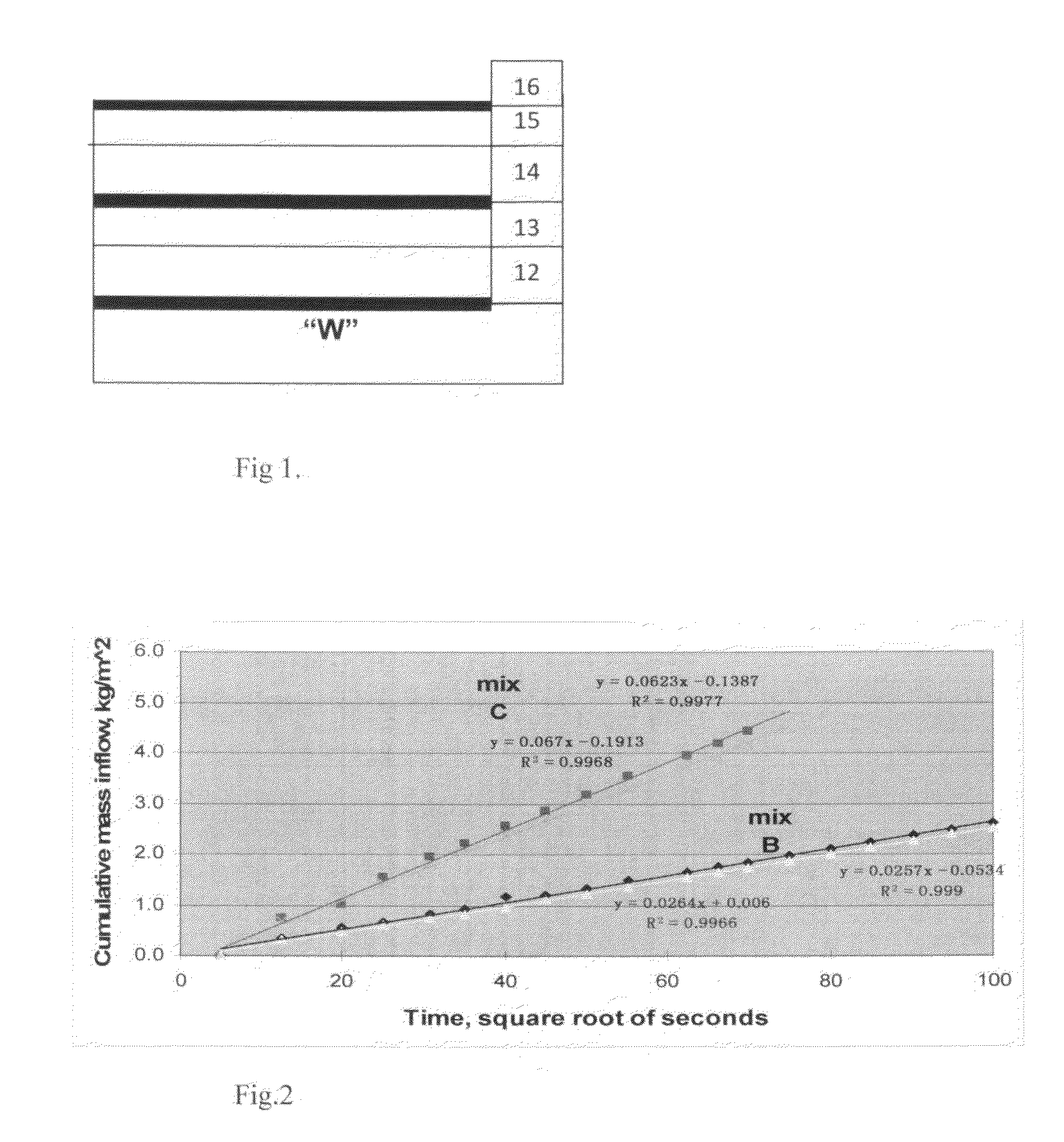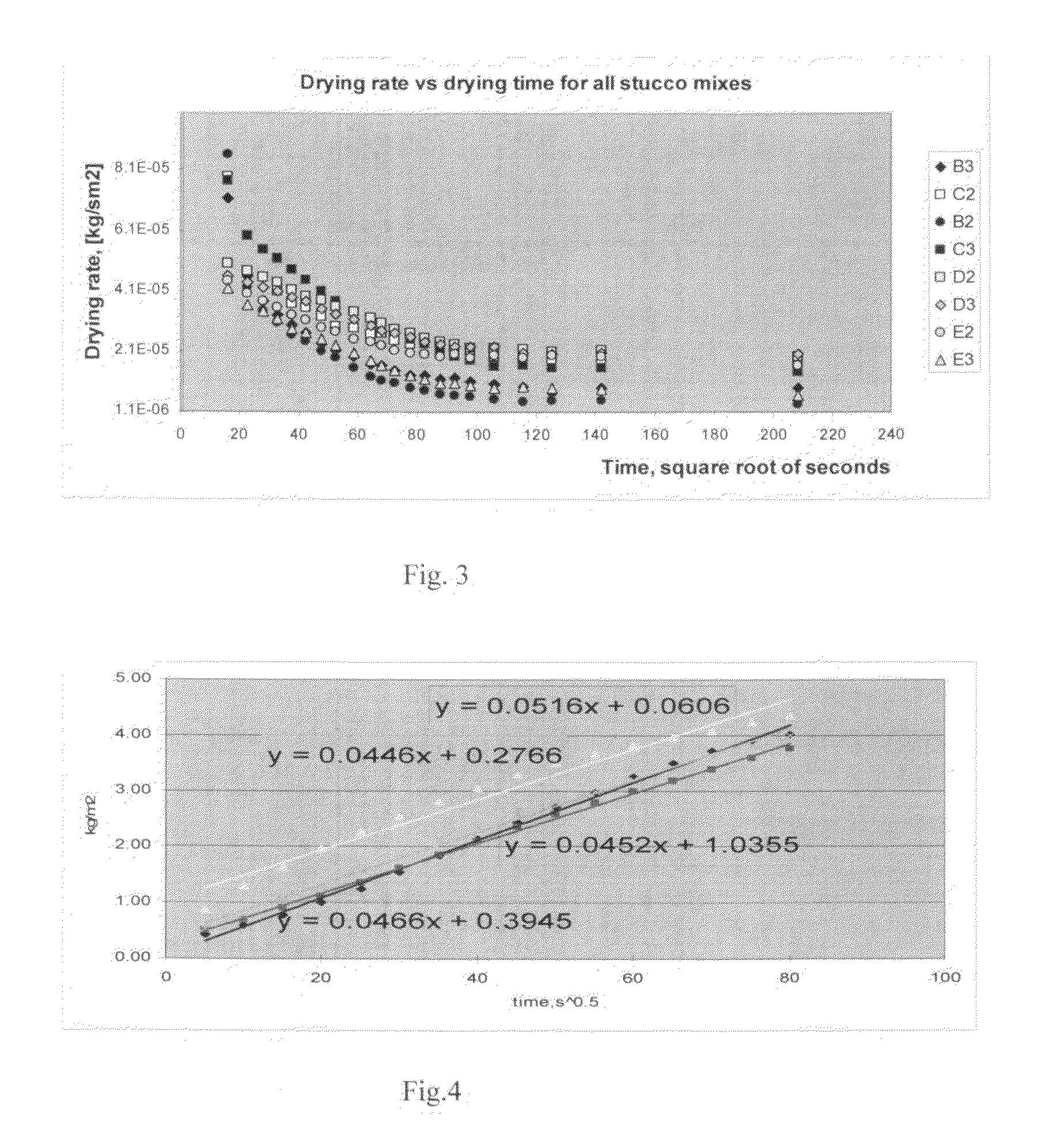Exterior building wall insulation systems with hygro thermal wrap
a technology of exterior building walls and thermal wraps, applied in the field of building materials, can solve the problems of lack of moisture storage capacity, lack of fire protection and drying ability of 3-coat portland cement plaster, and prone to cracking and subsequent moisture penetration of the exterior wall, etc., to achieve the effect of accelerating water removal, improving moisture transfer, and accelerating moisture removal
- Summary
- Abstract
- Description
- Claims
- Application Information
AI Technical Summary
Benefits of technology
Problems solved by technology
Method used
Image
Examples
example 1
Basic Concepts
[0034]Several laboratory samples of base coat of the HT wrap 10 were prepared and tested. The sample denoted “C” in FIG. 2 was produced with the ratio hydraulic lime:fly ash:cement:sand 1:1:1:6 while sample “B” represent a traditional base-coat of Portland Cement Plaster with the ration cement:lime:sand 1:0.25:4. Mixes C and D, shown in FIGS. 2 and 3 are binder compositions that are used in the following invention. Another mix, shown in FIGS. 4 and 5, also included as a partial subject of this invention used recycled polystyrene beads.
[0035]FIG. 2 is a graph with a Lime based binder mix C shows wetting from free water surface faster than mix B that is based on the standard Portland cement. Note that faster wetting also implies faster drying of the rain wetted material.
[0036]FIG. 3 is a graph showing Drying rate versus drying time measured on two specimens from different mixes (B-E). Mix B is based on standard Portland Cement, other mixes (C, D, E) are based on lime wit...
example 2
An HT wrap on Eco-Fiber Board External Insulation Systems for Cold Climate
[0040]Since 1994 flexible and rigid wood-fiber insulation boards have been produced in Germany in accordance with a standard WF-EN 13171-T3-CS (10 / Y) 20-TR7, 5-WS2, 0-MU5-AF100. When a multi-fiber system is used as an additive to the wood fibers to modify its physical properties this product is known as “Eco-fiber board”. FIG. 6 shows a system based on application of the rigid Eco-fiber board.
[0041]FIG. 6 is a cross-section example of an HT wrap 10, comprising layers 13-16, applied on Eco-fiber board 12 for cold climate application applied to a wall surface “W”.
[0042]The layer 12 here is Eco-fiber board from a special run of Homatherm GmbH in Berga, Germany. It has density about 120 kg / m3, a thermal conductivity measured at 10° C. equal to 0.037 W / mK or thermal resistivity of 3.9 (of hr ft2) / BTU in, specific heat 2100 J / (kgK) and thickness 80 mm (3¼ inch). It is adhered to the OSB substrate using Sto Corp manu...
example 3
Continuous External Insulation (SPF) Systems for warm climate
[0043]FIG. 7 shows an example of an HT wrap 10, comprised of layers 13-16, placed on Eco-fiber board and adhered with close cell polyurethane foam onto a wall surface “W” in warm climate application.
[0044]The insulation layer 12 represented here may be made of 1½ inch thick, close or open cell polyurethane foam. This could be either poured foam, applied with a typical 4 ft (1.2 m) height, between extruded polystyrene strips placed on each stud serving as both distance marks and locations of the mechanical fasteners locations or 2 component pressurized froth. In the latter case the maximum height of the insulation board is 2 ft (60 cm). In the actual example 3 different foams from two different manufacturers were used. One of the foams had CCMC 12840-Report that describes the technical features as follows: The final cured product has a nominal density of 30.4 kg / m3 and an assigned design thermal resistance of 1.05 m2·° C. / W...
PUM
| Property | Measurement | Unit |
|---|---|---|
| thickness | aaaaa | aaaaa |
| shrinkage | aaaaa | aaaaa |
| density | aaaaa | aaaaa |
Abstract
Description
Claims
Application Information
 Login to View More
Login to View More - R&D
- Intellectual Property
- Life Sciences
- Materials
- Tech Scout
- Unparalleled Data Quality
- Higher Quality Content
- 60% Fewer Hallucinations
Browse by: Latest US Patents, China's latest patents, Technical Efficacy Thesaurus, Application Domain, Technology Topic, Popular Technical Reports.
© 2025 PatSnap. All rights reserved.Legal|Privacy policy|Modern Slavery Act Transparency Statement|Sitemap|About US| Contact US: help@patsnap.com



